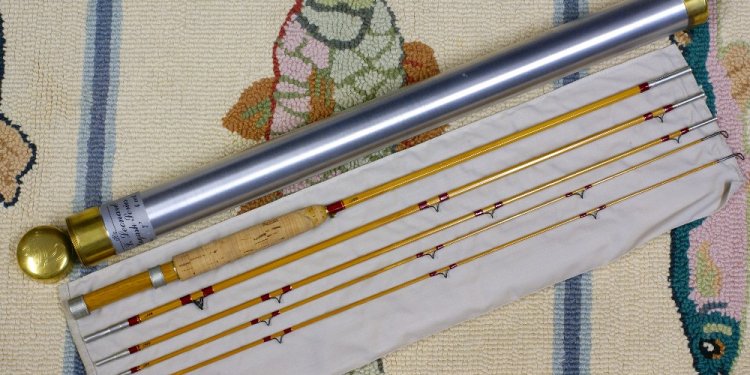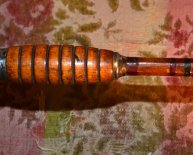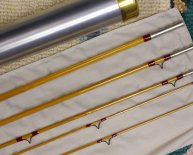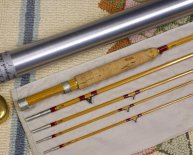
Bamboo Fishing Rods value
Casting a fly fishing rod versus other types of fishing has got the critical huge difference that unlike casting a bait or appeal where the fat of this bait draws the fishing line along behind; a fly is actually weightless. The result is the fact that fly-fisher is casting the range it self because of the fly along the trip. Therefore fly rods are generally longer and much more limber than many other types of fishing rods, additionally the design or "taper" of this rod dictates how good it performs. In the mid 19th century, manufacturers discovered that by splitting a stalk of bamboo into lengthy slivers known as splines; tapering those splines, and then glueing them together into a rod, had been the best response. Six splines are the near standard, though there being rods constructed with 8, 5, 4 and on occasion even two glued-up splines. For pretty much 100 years, split bamboo ended up being the only appropriate product by which to build a fly pole, and while the better creations may be masterpieces of design and craftsmanship over which enthusiasts drool and covet, each bamboo rods aren't valuable either as collectible memorabilia or as nevertheless useful fishing tools. In reality, through to the introduction of fiberglass after ww2, presision and awareness of detail made a bamboo models expensive beyond the reach of "Joe typical" and mass manufacturing businesses eg Horrocks and Ibbotson or Montague proved rods to offer at retail for as low as $.85. Whilst concept of "quality" is difficult to quantify, its a secure declaration that for virtually any good bamboo rod, possibly 1000 clunkers were produced. And because both high quality and size producers would private label rods for shoe dealers, equipment stores and these types of, plus entities like Montague additionally made some good designs, the brand name in the pole alone is not an entirely trustworthy indicator of quality. A discussion of what size or line size/weight is suitable is beyond the scope of this note, and assuming the seeker understands those responses, the question is just how to ID and value an excellent pole. 1. Most bamboo rods built from post US Civil War through to the 1930s had been in three parts (butt, mid and tip) and typically had been supplied with an extra tip. Rods are explained by the wide range of parts and set up spare occurs. Hence a 3/2 is a rod in three areas with two ideas. 2/1 is a two piece pole with an individual tip, etc. 2. In 99.9 per cent associated with the situations, each areas were created to the same size, of course a rod is marketed otherwise, whatever the description of this vendor, it is a good assumption that a quick area was damaged and fixed. This significantly reduces the value associated with the pole, as while an inch or two damaged off the end of a tip area may well not render the pole ineffective as a fishing tool, more make the rod ideal just as a source of parts to repair a like specimen. The conventional bamboo fly rod ended up being 9' lengthy or longer, and the modern fisher because of the even more lightweight alternatives available today, usually locates this common size fat. Shorter and lighter rods from bamboo era are far less common, and thus carry a value premium, often considerable, over longer rods. Said differently, the rareness and usefulness facets of a shorter than 9' pole raise the value, additionally the faster the first rod, the greater it is worth. This naturally excludes rods which have been altered (cut-off) by an owner. You will find three often trustworthy indicators of a rod assembled with focus on information and are also signs and symptoms of high quality. The first and easiest to identify would be the steel bones (ferrules) familiar with get in on the pole sections. If those ferrules seem to be chrome plated brass (think of the plumbing system under the kitchen sink), that is a strong indication of cheaper quality/value. Such ferrules can differ from becoming therefore soft concerning fold and fail by fishing, but perhaps the much better styles were used as a price savings because the perfect metal called nickel gold had been pricey to produce. NS ferrules can be identified as unlike chromed metal, along with indeed is much like great silverware (some NS ferrules were artificially darkened, for appearances and marketed as to prevent the expression spooking wary fish). Indicator #2 is difficult to identify from an auction listing image alone, but a stalk of bamboo has growth bands or "nodes" along its length, and these node points are weak places within the specific splines. Great makers ensured that after glued collectively, the nodes are put in order that not one tend to be alongside and thus create a potential weak area when you look at the rod. Mass manufacturing couldn't enable this extra action, and reduced quality rods typically have adjacent nodes which are often spotted as disruptions in the grain structure regarding the splines. Check point no. 3 is the top-notch the cork used for the pole's grip. Great cork has the fewest striations or whole grain line flaws, therefore the distinction between low-quality cork while the very best is a material price of 300percent or higher. If the photo associated with pole shows longitudinal "grain lines" being parallel to the rod shaft, and the a lot fewer the greater, it is an indication of quality. If the grip reveals spots instead of outlines of grain, this tells us the cork rings were cut so that the whole grain lines point inward so that they can make low quality cork appear "clean", but those inward pointing outlines may enable moisture to enter, in extreme situations sooner or later rotting the bamboo underneath. Once you have determined the product quality standard of the specimen pole and its particular general value level considering length therefore the size of line it had been developed to make use of, condition becomes the most important cost determinant. It must be relatively obvious that a rod in pristine, unfished "mint" problem will actually sell at an important advanced. However the purchaser has to be extremely alert to seller's hyperbole whenever explaining the rod as mint or excellent. Unlike most antiques in which initial and unrestored items carry premium over any refinished item, bamboo rods had been well-used by their owners, and a rod that usually is still a useful fishing tool utilizing the free tip still present; parts yet size, ferrules tightly fitted plus the guide wraps undamaged, will not drop the maximum amount of in worth as it is anticipated the master might have had the pole re-wrapped and fresh varnish used since necessary. If really or skillfully done, a refinished rod (which should be identified...

















